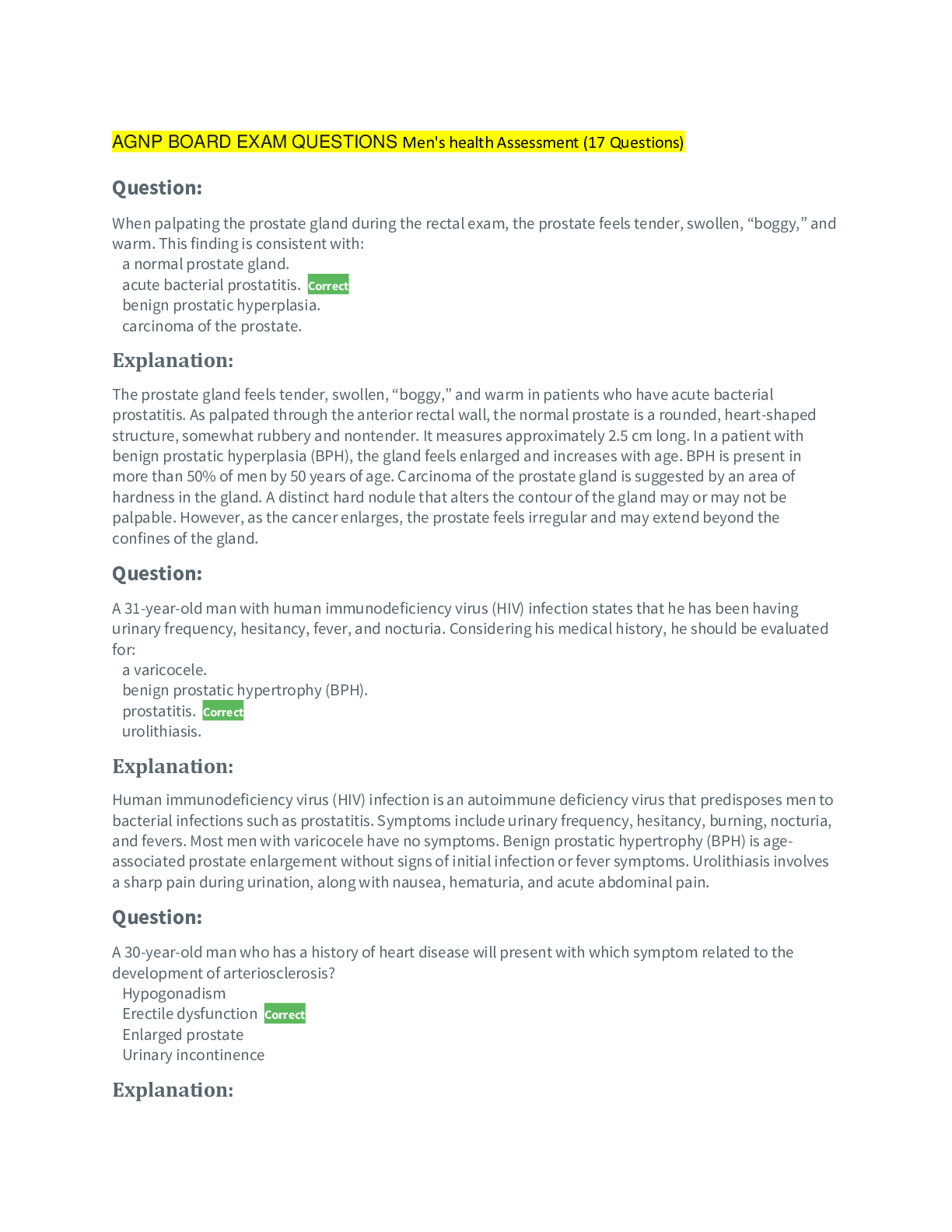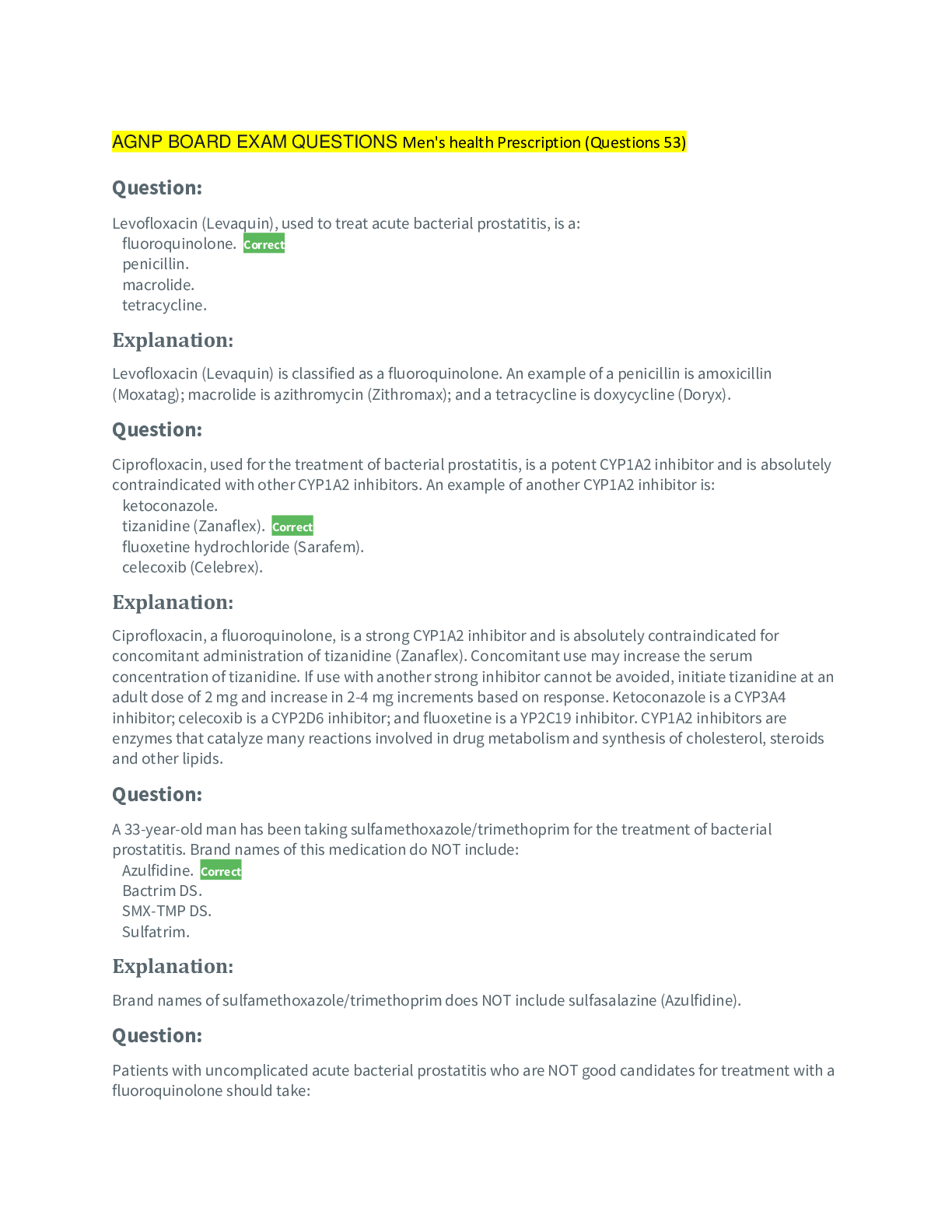*NURSING > EXAM > AGNP BOARD EXAM QUESTIONS Men's health Assessment (17 Questions) | GOLDEN A GRADE (All)
AGNP BOARD EXAM QUESTIONS Men's health Assessment (17 Questions) | GOLDEN A GRADE
Document Content and Description Below
AGNP BOARD EXAM QUESTIONS Men's health Assessment (17 Questions) Question: When palpating the prostate gland during the rectal exam, the prostate feels tender, swollen, “boggy,” and warm. Th... is finding is consistent with: a normal prostate gland. acute bacterial prostatitis. Correct benign prostatic hyperplasia. carcinoma of the prostate. Explanation: The prostate gland feels tender, swollen, “boggy,” and warm in patients who have acute bacterial prostatitis. As palpated through the anterior rectal wall, the normal prostate is a rounded, heart-shaped structure, somewhat rubbery and nontender. It measures approximately 2.5 cm long. In a patient with benign prostatic hyperplasia (BPH), the gland feels enlarged and increases with age. BPH is present in more than 50% of men by 50 years of age. Carcinoma of the prostate gland is suggested by an area of hardness in the gland. A distinct hard nodule that alters the contour of the gland may or may not be palpable. However, as the cancer enlarges, the prostate feels irregular and may extend beyond the confines of the gland. Question: A 31-year-old man with human immunodeficiency virus (HIV) infection states that he has been having urinary frequency, hesitancy, fever, and nocturia. Considering his medical history, he should be evaluated for: a varicocele. benign prostatic hypertrophy (BPH). prostatitis. Correct urolithiasis. Explanation: Human immunodeficiency virus (HIV) infection is an autoimmune deficiency virus that predisposes men to bacterial infections such as prostatitis. Symptoms include urinary frequency, hesitancy, burning, nocturia, and fevers. Most men with varicocele have no symptoms. Benign prostatic hypertrophy (BPH) is age-associated prostate enlargement without signs of initial infection or fever symptoms. Urolithiasis involves a sharp pain during urination, along with nausea, hematuria, and acute abdominal pain. Question: A 30-year-old man who has a history of heart disease will present with which symptom related to the development of arteriosclerosis? Hypogonadism Erectile dysfunction Correct Enlarged prostate Urinary incontinence Explanation: Erectile dysfunction is commonly caused by atherosclerosis in older men and is frequently considered a manifestation of vascular disease. Hypogonadism is caused by changes in testosterone. Prostate enlargement occurs in most older men and is not specifically related to heart disease. Urinary incontinence is a symptom associated with enlarged prostate and is not specific to atherosclerotic changes. Question: At what age should a practitioner suggest a colonoscopy for a male patient as part of primary care screening? 40 years 45 years 50 years Correct 55 years Explanation: The American Cancer Society recommends that a colonoscopy for colorectal cancer screening be performed at age 50 and every 10 years afterward, as long as screening is negative. Testing prior to age 50 depends on risk factors such as family history or history of inflammatory bowel disease. Question: When the scrotum is transilluminated in a 4-month-old boy, it lights up brightly. This finding may be consistent with: normal scrotal findings. an inguinal hernia. cryptorchidism. a hydrocele. Correct Explanation: A hydrocele is defined as swelling in the scrotum that lights up on transillumination. Inguinal hernia and cryptorchidism are diagnosed using palpation of the scrotum and testicle and are not associated with fluid collection. Swelling of the scrotum and collection of serous fluid are not normal findings. Question: When examining the prostate gland the examiner should inform the patient that this procedure may: cause him to urinate. prompt an urge to defecate. prompt an urge to urinate. Correct cause him to cough. Explanation: When examining the prostate gland on a male patient, the examiner should inform the patient that this procedure may prompt an urge to urinate but reassure him that he will not void on himself. Question: An occurrence of benign mammary tissue hypertrophy in men that causes enlargement of the breast tissue is called: dermoid cyst. gynecomastia. Correct neurofibroma. hypogonadism. Explanation: Gynecomastia is a benign mammary tissue hypertrophy in men that causes enlargement of the breast tissue. A dermoid cyst is a small noncancerous lump in the skin that is present at birth. A neurofibroma is a benign nerve sheath tumor in the peripheral nervous system that forms in the brain or spinal cord. Hypogonadism is a failure of the testes to function properly. Question: When palpating the prostate gland during the rectal exam, the prostate feels enlarged and nontender. This finding is consistent with: a normal prostate gland. acute bacterial prostatitis. benign prostatic hyperplasia. Correct carcinoma of the prostate. Explanation: In a patient with benign prostatic hyperplasia (BPH), the gland feels enlarged and increases in size with age. BPH is present in more than 50% of men by 50 years of age. As palpated through the anterior rectal wall, the normal prostate is a rounded, heart- shaped structure, somewhat rubbery and nontender. It measures approximately 2.5 cm long. With acute bacterial prostatitis, the prostate gland feels tender, swollen, “boggy,” and warm. Carcinoma of the prostate gland is suggested by an area of hardness in the gland. A distinct hard nodule that alters the contour of the gland may or may not be palpable. However, as the cancer enlarges, the prostate gland feels irregular and may extend beyond the confines of the gland. Question: Which screening is commonly used in the diagnosis of prostate cancer in men 50 years and older? PSA level Correct Digital rectal exam Urinalysis Prostate biopsy Explanation: Prostate cancer screening involves a blood test that measures prostate-specific antigen (PSA). A rectal examination is sometimes recommended in addition to measurement of the PSA. However, studies have NOT shown that rectal examination alone is an effective screening test for prostate cancer. A prostate biopsy is a more invasive screening that is usually obtained after elevated PSA levels and abnormal rectal examination. Urinalysis is not indicated as a screening tool for prostate cancer. Question: Which examination finding is defined as a congenital ventral displacement of the meatus on the penis? Balanitis Posthitis Phimosis Hypospadias Correct Explanation: Hypospadias is a congenital ventral displacement of the meatus on the penis. Balanitis is an inflammation of the glans of the penis. Posthitis is an inflammation of the foreskin. Phimosis is a congenital narrowing of the opening of the foreskin so that it cannot be retracted. Question: A 26-year-old man with a past medical history of sickle cell disease arrives at the office with complaints of a penile erection that has lasted 4 hours. He is experiencing symptoms of: low flow priapism. Correct Peyronie disease. acute balanitis. side effect of opioids. Explanation: Low flow priapism is common in sickle cell patients. Priapism is a penile erection lasting more than 4 hours without stimulation. Peyronie disease, acute balanitis, and opioid side effects result in inability to achieve or difficulty maintaining an erection. Question: When palpating the prostate gland during the rectal exam, an area of hardness is noted on the posterior side of the gland. This finding is most consistent with: a normal prostate gland. acute bacterial prostatitis. benign prostatic hyperplasia. carcinoma of the prostate. Correct Explanation: Carcinoma of the prostate is suggested by an area of hardness in the gland. A distinct hard nodule that alters the contour of the gland may or may not be palpable. However, as the cancer enlarges, the prostate gland feels irregular and may extend beyond the confines of the gland. As palpated through the anterior rectal wall, the normal prostate gland is a rounded, heart-shaped structure, somewhat rubbery and nontender. It measures approximately 2.5 cm long. With acute bacterial prostatitis, the prostate gland feels tender, swollen, “boggy,” and warm. In a patient with benign prostatic hyperplasia (BPH), the gland feels enlarged and increases in size with age. BPH is present in more than 50% of men by 50 years of age. Question: During assessment of a 3-month-old boy, an incomplete descent of the left testicle into the scrotum is noted. The practitioner understands that: testicles should descend by 6 months of age. Correct testicles will not spontaneously descend. an abdominal ultrasound should be ordered. a referral to a pediatric urologist is indicated. Explanation: Male infants with cryptorchidism experience incomplete descent of one or both testicles into the scrotum. Urology evaluation should be considered if the testicle is not descended by 6 months of age. Orchiopexy surgery is not performed until symptoms persist after 1 year. 75% of full-term and 95% of premature cryptorchid testes descend spontaneously by 1 year of age. Question: When assessing for the presence of a direct inguinal hernia in a man, the practitioner should palpate for a distinct bulge while instructing the patient to: hold a breath. lift one leg. cough. Correct bear down. Explanation: Examination for an inguinal hernia is performed by palpating the external inguinal ring. This procedure is performed while asking the patient to cough as the examiner palpates for a distinct bulge or mass. Question: A 21-year-old man presents with complaints of a palpable, painless, freely movable cystic mass in the scrotum. On assessment, the mass transilluminates and measures 2.5 cm in size. These findings suggest: a varicole. a hydrocele. epididymitis. a spermatocele. Correct Explanation: A spermatocele is an asymptomatic benign fluid-filled cystic structure located in the scrotum along the spermatic cord. It measures larger than 2 cm and is easily transilluminated and freely palpable. Varicocele is a collection of abnormally large dilated veins in the scrotum. Hydrocele is a collection of serous peritoneal fluid within the scrotum. Epididymitis is an inflammation of the epididymis causing tenderness and discomfort. Question: An 18-year-old man presents with an acute onset of left testicular pain and loss of cremasteric reflex on the affected side. These findings suggest: epididymitis. testicular torsion. Correct scrotal trauma. orchitis. Explanation: An absent cremasteric reflex is the most sensitive sign of testicular torsion. The reflex is present in epididymitis and orchitis, and variable in scrotal trauma. Question: A 30-year-old man is seen in the clinic for complaints of scrotal irritation, bilateral testicular pain, and enlarged lymph nodes in the groin that began 2 weeks after having unprotected intercourse. This subjective history describes: epididymitis. Correct testicular torsion. urinary tract infection. idiopathic sacral edema. Explanation: Epididymitis is commonly caused by a sexually transmitted infection (STI) and presents as scrotal irritation, bilateral testicular pain, and enlarged lymph nodes. Urinary tract infections (UTIs) include symptoms associated with urination and do not usually feature testicular or scrotal involvement. Testicular torsion causes acute, unilateral testicular pain. Idiopathic sacral edema presents as swelling of the scrotum with fluid accumulation. It presents as unilateral erythema of the scrotal skin. [Show More]
Last updated: 2 years ago
Preview 1 out of 6 pages

Buy this document to get the full access instantly
Instant Download Access after purchase
Buy NowInstant download
We Accept:

Reviews( 0 )
$6.00
Can't find what you want? Try our AI powered Search
Document information
Connected school, study & course
About the document
Uploaded On
May 15, 2021
Number of pages
6
Written in
Additional information
This document has been written for:
Uploaded
May 15, 2021
Downloads
0
Views
81




 Questions and Answers 100% VERIFIED.png)
 Questions and Answers 100% correct Solutions.png)






.png)






